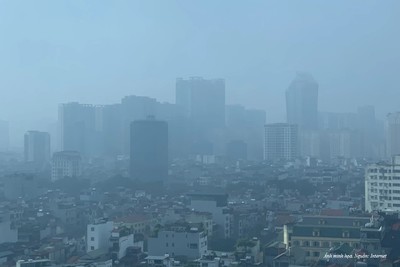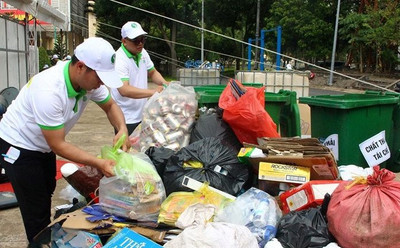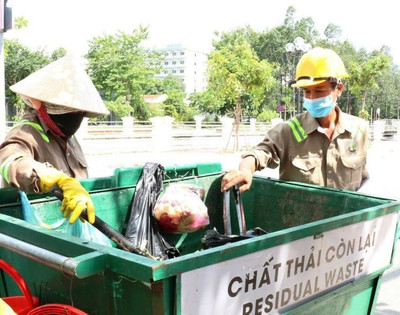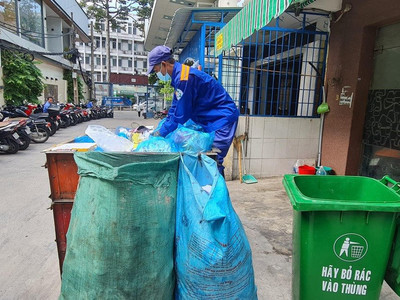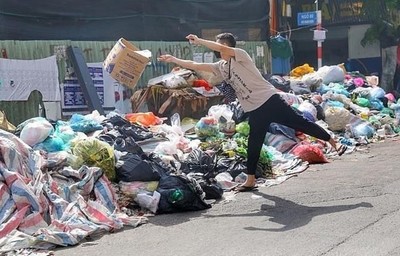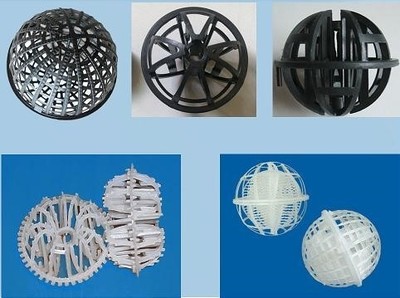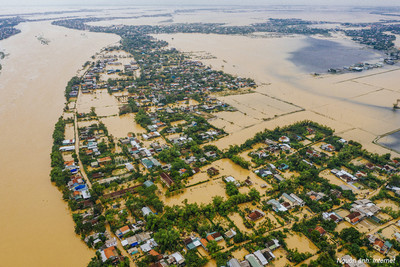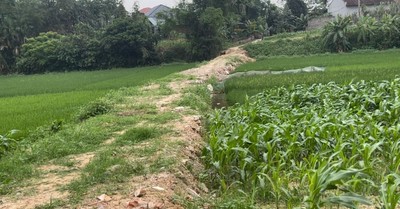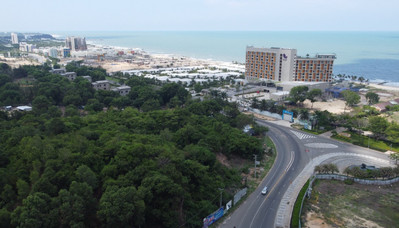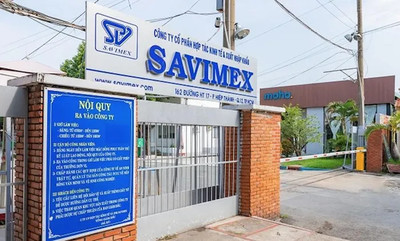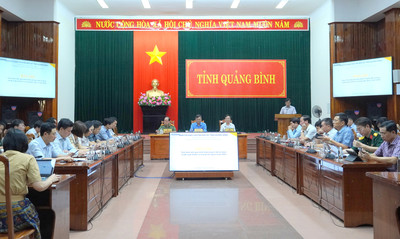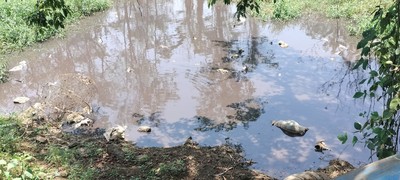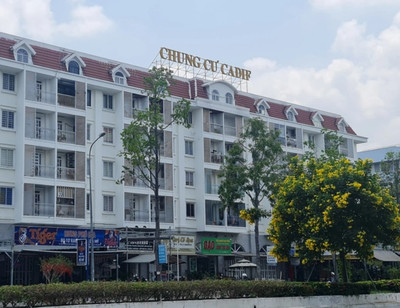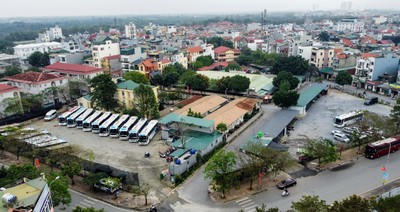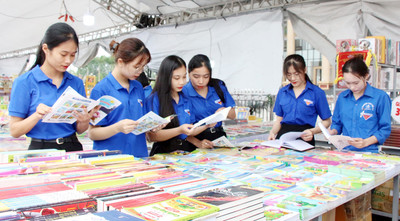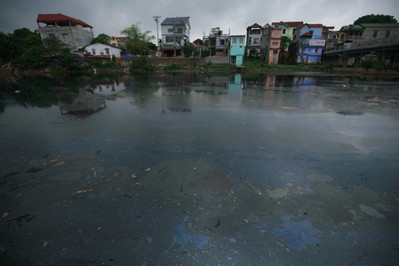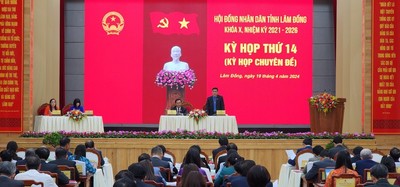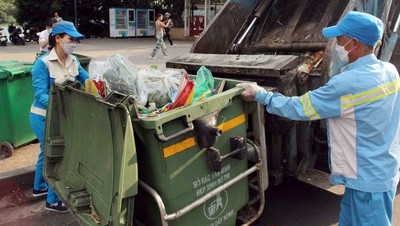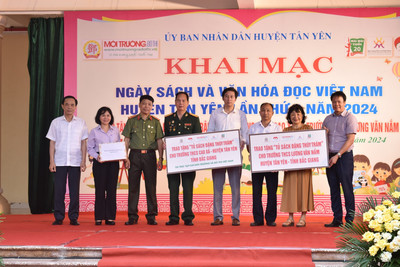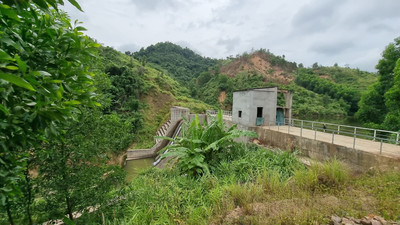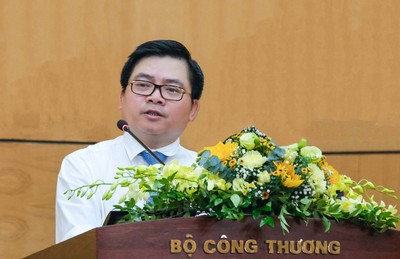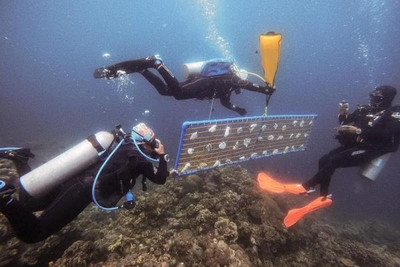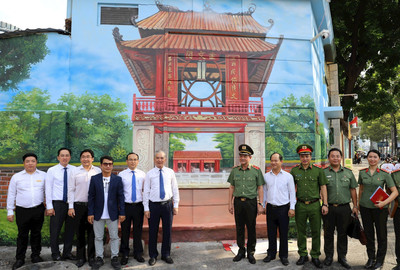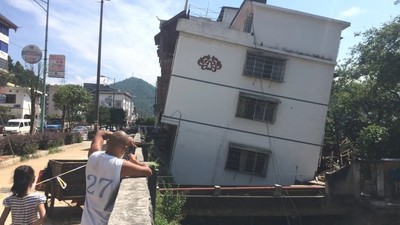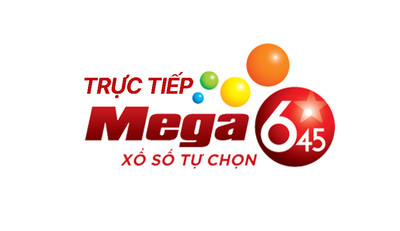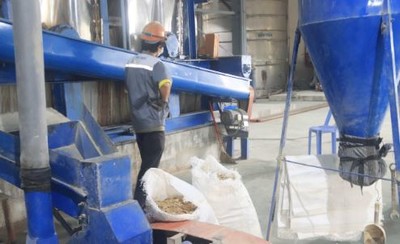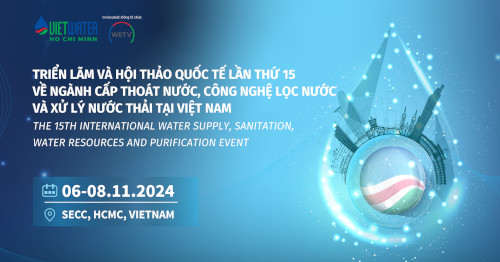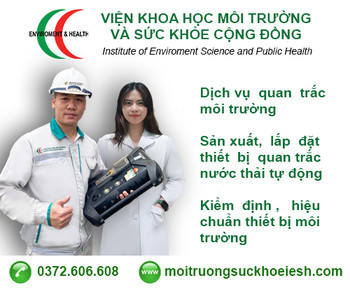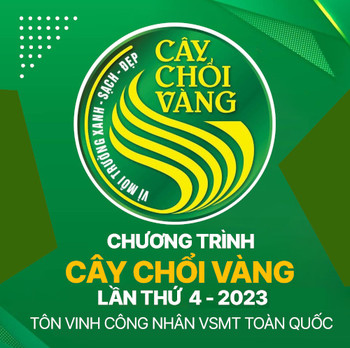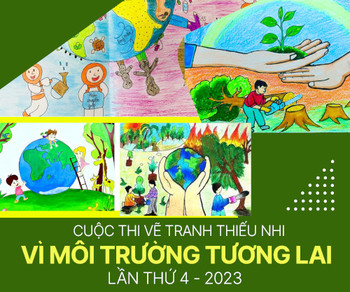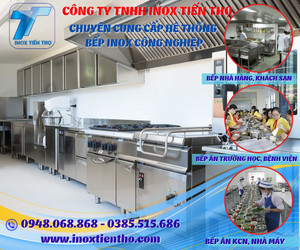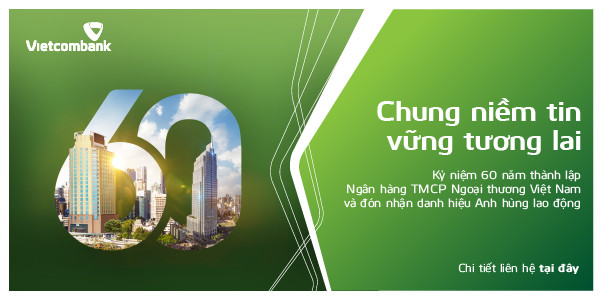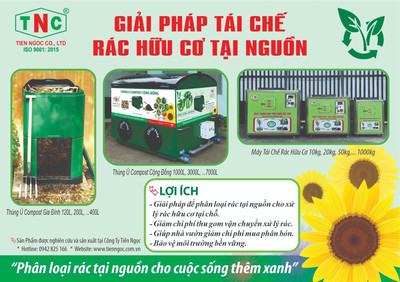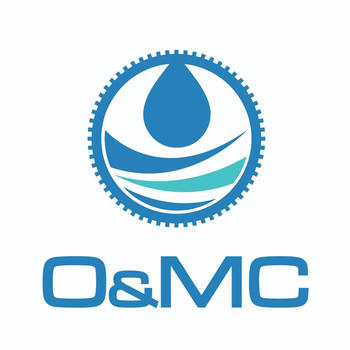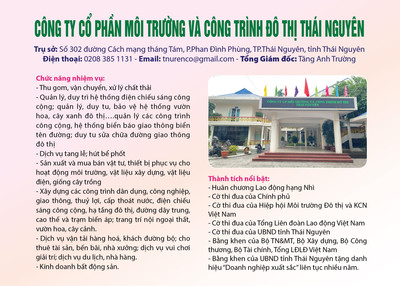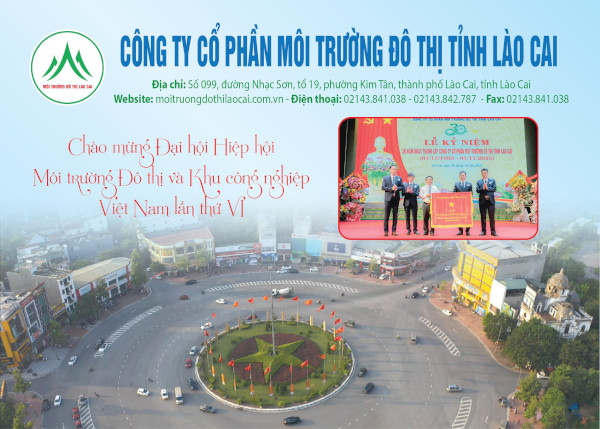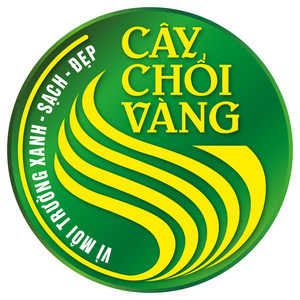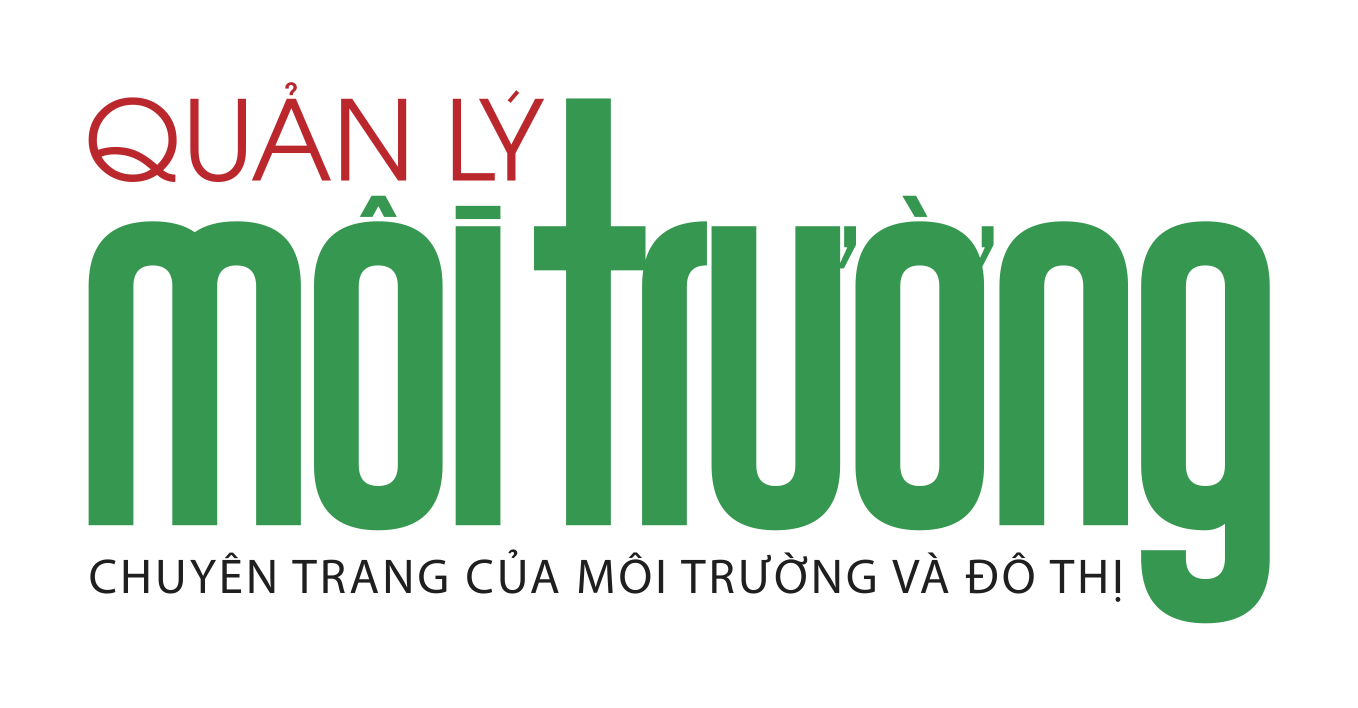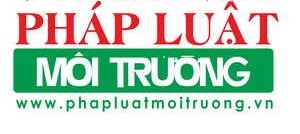Công bố Quốc tế lĩnh vực môi trường số 8-2022
Trân trọng giới thiệu tới quý độc giả Công bố Quốc tế lĩnh vực môi trường số 8-2022 với các công trình nghiên cứu của các nhà khoa học nổi tiếng từ nhiều quốc gia khác nhau và đã được công bố trên những tạp chí uy tín thế giới.
Công bố Quốc tế lĩnh vực môi trường số 8-2022 sẽ có 18 bài nghiên cứu về quản lý môi trường, 15 bài về môi trường đô thị và 15 bài về môi trường khu công nghiệp. Đặc biệt trong số 15 bài nghiên cứu về môi trường khu công nghiệp có bài nghiên cứu với chủ đề "Đánh giá về các quá trình oxy hóa nâng cao được hỗ trợ bởi vi sóng để xử lý nước thải” đã được chia sẻ trên trang Chemosphere, số 287, Phần 2 vào tháng 1/ 2022.
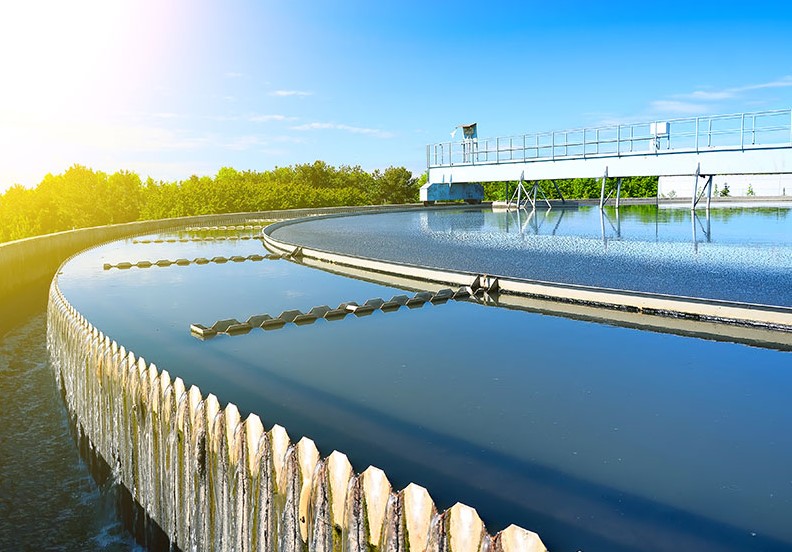
Các tác giả của nghiên cứu cho biết, công nghệ vi sóng (MW) ngày càng được quan tâm trong xử lý nước thải do các đặc tính độc đáo của nó, chẳng hạn như gia nhiệt nhanh và đồng đều, hiệu ứng điểm nóng và hiệu ứng không nhiệt. MW tăng cường sản xuất các gốc hoạt động (ví dụ như chấm OHradical, chấm gốc SO4), tạo ra hiệu quả điều trị tích hợp mạnh hơn kết hợp với các quá trình oxy hóa nâng cao.
Trong những năm qua, các quá trình oxy hóa tiên tiến có sự hỗ trợ của vi sóng (MW-AOP) đã phát triển nhanh chóng để phân hủy các chất ô nhiễm như các phương pháp xử lý sáng tạo.
Nghiên cứu phân loại chi tiết và đánh giá toàn diện về MW-AOPs. Các ứng dụng mới nhất của MW trong các hệ thống oxy hóa tiên tiến khác nhau (hệ thống oxy hóa, hệ thống oxy hóa xúc tác, các hệ thống quang hóa, điện hóa và sono hóa) đã được đề cập trong nghiên cứu.
Trong nghiên cứu nói trên, các nhà khoa học cũng đã đưa ra các ý kiến thải luận về các thông số phản ứng và hiệu suất của MW-AOPs trong xử lý nước thải, đồng thời nhấn mạnh việc tăng cường phân huỷ chất ô nhiễm theo MW. Ngoài ra, chi phí vận hành của MW-AOPs cũng được nghiên cứu đánh giá cụ thể.
Từ những phân tích và đánh giá, các nhà nghiên cứu đã đưa ra các khuyến nghị về MW-AOPs để giới chuyên gia có thể nghiên cứu trong tương lai. Có thể nói, nghiên cứu này cung cấp những thông tin có ý nghĩa về sự phát triển và tiềm năng của MW-AOPs.
Dưới đây là Công bố quốc tế lĩnh vực môi trường số 8-2022 với những nội dung chính như sau:
Về quản lý môi trường
- Lợi ích kinh tế và khí hậu của phương tiện nối lưới đối với quá trình chuyển đổi các-bon thấp của hệ thống điện: Một nghiên cứu điển hình về mục tiêu năng lượng tái tạo năm 2030 của Trung Quốc.
- Tổng quan về việc thực hiện thuế môi trường và các công cụ kinh tế liên quan ở các quốc gia điển hình.
- Cái giá thực sự của việc giải quyết thách thức rác thải nhựa ở các nước đang phát triển: Trường hợp của Ghana.
- Ước tính từ dưới lên về quá trình khử cacbon sâu trong ngành sản xuất của Hoa Kỳ vào năm 2050.
- Các tác động của cơ chế mua bán phát thải carbon đối với lộ trình chuyển đổi quyền lực - lấy ví dụ như khu vực Vịnh lớn Quảng Đông-Hồng Kông-Macao.
- Hệ thống quản lý môi trường có thúc đẩy sự phát triển xanh của các ngành công nghiệp gây ô nhiễm nhiều của Trung Quốc không?
- Mô phỏng hay ước tính? - Hai cách tiếp cận để tính toán lợi ích tài chính của các cộng đồng năng lượng.
- Đóng góp của các công cụ quản lý khu vực biển cho các mục tiêu phát triển bền vững của Liên hợp quốc.
- Lộ trình chuyển đổi hệ thống năng lượng thành phố bền vững: Một nghiên cứu điển hình về Đường Sơn, một thành phố dựa vào tài nguyên ở Trung Quốc.
- Hiệu quả năng lượng của các chiến lược thiết kế làm mát thụ động để giảm tác động của sóng nhiệt lâu dài đối với sự thoải mái nhiệt của người cư ngụ ở Châu Âu: Biến đổi và giảm thiểu khí hậu.
Về môi trường đô thị
- Một nghiên cứu so sánh về các mô hình phát triển đất và môi trường nhiệt khu vực (RTE) trong các khu tập hợp đô thị điển hình của Trung Quốc và Mỹ: Một nghiên cứu điển hình về Bắc Kinh-Thiên Tân-Hà Bắc (BTH) và Boswash.
- Lập bản đồ đa dạng sinh học và dịch vụ hệ sinh thái: Liệu nó có thể dung hòa giữa quy hoạch đô thị và khu bảo tồn?
- Phản ứng khác nhau của hiện tượng thực vật đối với quá trình đô thị hóa: Một nghiên cứu điển hình về thành phố Bắc Kinh, Trung Quốc.
- Đánh giá tổng hợp về tác động nóng lên của đô thị hóa và nông nghiệp trong các khu đô thị phát triển cao của Trung Quốc.
- Chất thải rắn đô thị tồn đọng làm đồng chất nền tại các nhà máy xử lý nước thải: Đánh giá năng suất mêtan, tiềm năng khử nước và đa dạng vi sinh vật.
- Đặc điểm số lượng và đa dạng di truyền liên quan đến các con đường chu trình N ở các sông đô thị với các kỹ thuật xử lý khác nhau.
- Đánh giá hiệu quả và động lực của hệ thống sử dụng nước và xử lý nước thải đô thị tổng hợp: Bằng chứng từ dữ liệu bảng không gian về sự kết tụ đô thị ở trung lưu sông Dương Tử.
- Nồng độ, sự phân bố không gian, các nguồn và rủi ro sức khỏe môi trường của các yếu tố độc hại tiềm ẩn trong bụi đường đô thị trên khắp Trung Quốc.
- Khả năng xảy ra đại dịch đối với chất lượng không khí: Quan điểm về khả năng chống chịu của đô thị.
Về môi trường khu công nghiệp
- Đặc trưng cho sự hình thành tắc nghẽn màng trong quá trình siêu lọc nước thải hữu cơ có độ mặn cao.
- Các sửa đổi từ than bùn và bentonit hỗ trợ tái tạo không đất của các đuôi kim loại màu ô nhiễm kim loại nặng và ô nhiễm kim loại nặng.
- Tạo năng lượng sinh học và xử lý nước thải của xưởng thuộc da bằng cách sử dụng pin nhiên liệu vi sinh.
- Những thay đổi theo thời gian trong các vũng chứa asen và chì trong trầm tích bị ô nhiễm được sửa đổi bằng than sinh học bị nhiệt phân ở các nhiệt độ khác nhau.
- Rác thải điện tử như một nguồn ô nhiễm nguyên tố đất hiếm: Rửa trôi, vận chuyển trong môi trường xốp và ảnh hưởng của các hạt nano.
- Đánh giá về các quá trình oxy hóa nâng cao được hỗ trợ bởi vi sóng để xử lý nước thải.
- Hiệu quả loại bỏ cao các hợp chất độc hại công nghiệp thông qua phản ứng xúc tác ổn định trong hệ thống xử lý nước.
- Loại bỏ rhodamine B khỏi nước thải dệt nhuộm bằng cách sử dụng chất xúc tác quang hạt nano: Đánh giá về các phương pháp tiếp cận bền vững.
- Khảo sát khả năng lưu giữ amoni bằng màng lọc nano gốm graphene oxit để xử lý nước thải bán dẫn.
- Xử lý tại chỗ đất bị ô nhiễm kẽm bằng cách sử dụng sản phẩm thu hồi phốt pho: Hydroxyapatite/canxi silicat hydrat (HAP/C - S - H).
Sau đây là tên và phần tóm tắt các bài nghiên cứu bằng tiếng Anh:
QUẢN LÝ MÔI TRƯỜNG
1. Economic and climate benefits of vehicle-to-grid for low-carbon transitions of power systems: A case study of China's 2030 renewable energy target
Journal of Cleaner Production, Volume 330, 1 January 2022, 129833
Abstract
More and more attention has been given to the role of electric vehicles in reducing the economic cost and carbon emissions of the power system through the vehicle-to-grid (V2G) mode, as well as helping to integrate renewable energy power. The promotion of V2G mode needs to consider the effectiveness of policy costs, so it is urgent to estimate the potential benefits of V2G. In this paper, a multi-regional power dispatch and expansion model is constructed from the perspective of power system by taking China's plan to reach 1.2 billion kW of installed wind and photovoltaic power generation capacity in 2030 as an example, combining with the development planning of electric vehicles and power systems. The results show that by 2030, the implementation of unidirectional V2G and bidirectional V2G in China can reduce the total cost of power system by 2.02% and 2.08%, reduce the annual carbon emissions of the power system by 2.27% and 2.95%, and increase the total proportion of wind and photovoltaic power generation by 1.33% and 1.28% in the power mix. An increasing proportion of electric vehicles participate in V2G increases the proportion of new-installed wind generation and decreases that of photovoltaic power. Due to the high cost of battery degradation and the current power mix dominated by coal-fired generation, additional benefits of implementing bidirectional V2G over unidirectional V2G are limited.
2. An overview on implementation of environmental tax and related economic instruments in typical countries
Journal of Cleaner Production, Volume 330, 1 January 2022, 129688
Abstract
Implementation of environmental taxation to internalize environmental externalities has been conducted for several decades in developed countries. With social and economic development, many developing countries arrive at their stage of carrying out environmental taxation reform in order to realize cleaner production and sustainable development. Aiming at providing experiences on establishing environmental taxation system for developing countries, current study reviewed scope, tax base, tax rate, tax preferences, monitoring and calculation method of pollutants, collection and management modes and implementation effects based on data retrieved from institutional and governmental website, and related research articles. The structure of tax base, typical economic instruments used, operation mechanism, and management mode were summarized. Legislation and institutional design, education and publicity, and administration and management were found to be the key aspects of implementation. Current trends in development were also discussed. This work contributes to provide reference and inspiration for developing countries to establish environmental taxation system in accordance with their national conditions based on social and historical background and economic structure.
3. The true cost of solving the plastic waste challenge in developing countries: The case of Ghana
Journal of Cleaner Production, Volume 330, 1 January 2022, 129649
Abstract
Mismanaged plastic waste is a major environmental concern, especially in countries of the Global South. Municipal solid waste management can not only alleviate environmental problems but also create jobs and promote local economic growth. However, providing appropriate waste management services is costly. The question is to what extent waste management policies that have proven to be successful in other geographies can help solve the challenge in developing countries. Specifically, the economics and financial flows along the value chain need to be known. In this paper, we shed light on these questions by presenting a novel, model-based method to elicit and assess the cost structure of the recycling sector in developing countries. We exemplify our method with plastics waste management in the Greater Accra Region of Ghana—an area particularly challenged by plastic waste. For this purpose, we surveyed over 80 participants of the waste management value chain and combined the data with insights from expert interviews and workshops. Based on this data, we built a bottom-up model with 67 parameters, reflecting all cost positions in the waste management value chain. We found that street waste pickers are the poorest and most vulnerable, earning only a fraction of the already low minimum wage. Middlemen and aggregators, while often being criticized for their earnings, also provide social-security-like services to waste pickers. In addition, formal and informal recyclers differ not only in earnings and size but also in recyclate quality where the informal sector provides higher quality.
4. Bottom-up estimates of deep decarbonization of U.S. manufacturing in 2050
Journal of Cleaner Production, Volume 330, 1 January 2022, 129758
Abstract
The world needs to rapidly reduce emissions of carbon dioxide (CO2) emission to stave off the risks of disastrous climate change. In particular, decarbonizing U.S. manufacturing industries is particularly challenging due to the specific process requirements. This study estimates the potential for future CO2 emission reductions in this important sector. The analysis is a detailed accounting exercise that relies on estimates of emission-reduction potential from other studies and applies those potentials to the manufacturing sector using a bottom-up approach. The actions are grouped into four "pillars” that support deep decarbonization of manufacturing (DDM): Energy Efficiency, Material Efficiency, Industry-Specific, and Power Grid. Based on this bottom-up approach, the analysis shows that an 86% reduction in carbon dioxide emissions from the Reference Case is feasible. No single pillar dominates DDM, although opportunities vary widely by sub-sector. The analysis shows that a strategy incorporating a broad set of elements from each pillar can be effective instead of relying on any single pillar. Some pillars, such as Energy Efficiency and Material Efficiency, have wide applicability; others have key niche roles that are Industry-Specific; the Power Grid pillar requires interaction between grid decarbonization and industry action to switch from fossil fuels to zero-carbon electricity where appropriate.
5. The impacts of carbon emission trading mechanism on the power transition pathway -taking Guangdong-Hong Kong-Macao Greater Bay Area as an example
Journal of Cleaner Production, Volume 330, 1 January 2022, 129894
Abstract
Carbon emission trading mechanism is an important market-based instrument to address global climate change. The auction ratio and price of carbon emission allowances (CEA) are cores of the carbon emission trading mechanism. What combination of CEA auction ratio and auction price is most conducive to carbon emission reduction for emission control enterprises? There are still relatively few studies conducted on this issue, and there is no clear answer from the views of theory and practice. In this paper, the AIM/Enduse model was used to analyze the changes and differences of installed power capacity, power supply, energy consumption and carbon emissions in the Guangdong-Hong Kong-Macao Great Bay Area (GBA) with different combinations of CEA auction ratios and prices. Moreover, the best pathway of energy transition was explored in the power industry of the GBA, and the best combination of CEA auction ratios and prices was identified in the GBA. The results show that: (1)The carbon emission constraint starts to work only when the auction ratio of CEA is increased to 50% and the auction price is increased to 60 CNY/ton (Scenario p3). When the auction ratio of CEA is 100% and the auction price reaches 120 CNY/ton (Scenario p5), a low-carbon transition of the power sector in the GBA can be achieved. (2) Under scenario p5, the total cost of power transition rises and then falls. And the cost of carbon in the power sector increases exponentially as the auction ratio of CEA and the auction price rise. However, the growth in the cost of power supply is relatively flat, which shows that appropriate carbon trading mechanism can improve the economic benefits of power sectors. With the increase of installed capacity of clean low-carbon energy generation and power supply, as well as the decrease of local power cost in the GBA, the proportion of outsourcing power can be appropriately reduced in the future, with an aim to reduce the external dependence of electricity to ensure the security of energy supply. In the end, it suggests that cities in the GBA should give full play to their regional advantages and establish a unified carbon emission trading market in the GBA as soon as possible. This study provides a theoretical basis for the supplementation and improvement of China's carbon emission trading mechanism.
6. Does environmental regulatory system drive the green development of China's pollution-intensive industries?
Journal of Cleaner Production, Volume 330, 1 January 2022, 129832
Abstract
Green development is a common goal pursued globally for carbon neutrality, and whether environmental regulatory system drives it in pollution-intensive industries (PIIs) is puzzled. Using provincial panel data of Chinese PIIs during 2005–2017, this paper applied entropy method to integrate existing environmental regulatory system into three types of environmental regulations, and then explored non-linear effects of them on green total factor productivity (GTFP). Several conclusions are generated. The annual growth rate of GTFP is 10.61% and it presents industrial differences. Technical change is the driving factor, while technical efficiency shows inhibiting effect. The effect of command-and-control environmental regulation on GTFP is a significant inverted U-shape curve, which is currently the primary driving role in green development, but it is too strict and increasingly less effective. Both market incentive and voluntary environmental regulations appear as positive U-shape curves, and their proper enhancement is breakthrough for future green development. Besides, market incentive environmental regulation is more effective in PIIs with relatively low pollution, while voluntary environmental regulation is sensitive to PIIs with relatively serious pollution. The Chinese government should allow environmental regulatory system more marketability and voluntariness, and production characteristics and pollution density of targeted industries should be considered.
7. Simulation or estimation?—Two approaches to calculate financial benefits of energy communities
Journal of Cleaner Production, Volume 330, 1 January 2022, 129733
Abstract
To date, studies examining the profitability of energy communities (ECs) with a specific focus on the distribution of energy and costs between participants have mostly proposed complex optimisation algorithms built upon household flexibility potential. In practice, however, the majority of households are not equipped with load-scheduling equipment. Therefore, this work introduces, a simulation model that aims to better reflect reality in order to assess electricity flows and the according costs in a renewable energy community (REC). To this end, two different distribution keys – static and dynamic allocation – are applied, and their implications are quantified. However, aside from realistic simulation models, simpler tools for assessing the economic viability of RECs are also required. Such tools may support the rapid diffusion of energy community concepts since potential participants are enabled to quantify financial benefits. For this purpose, an estimation model that requires no fine-grained load/generation profiles or significant computing power is presented. Since such a tool is only useful if the estimation still generates realistic outputs, its accuracy is evaluated by comparing the results it yields to those of the simulation. The calculations are conducted for a fictitious REC of ten single-family dwellings, of which five are equipped with a rooftop photovoltaic (PV) system. The results show that dynamic allocation increases the efficiency of electricity use compared to static allocation, thus benefitting all participants since the local electricity consumption is increased by 10 % on average. Comparing the results of the simulation and the estimation allows to conclude that a realistic assessment of an EC’s profitability can indeed be provided with proper assumptions.
8. Contributions of marine area-based management tools to the UN sustainable development goals
Journal of Cleaner Production, Volume 330, 1 January 2022, 129910
Abstract
Area-Based Management Tools (ABMTs) are spatial instruments for conservation and managing different forms of ocean use. A multitude of ABMTs exists in marine areas within and beyond national jurisdiction, ranging from tools for the regulation of specific human activities (e.g. fisheries, shipping, or mining) to cross-sectoral tools (e.g. such as marine protected areas, MPAs, and marine spatial planning, MSP). By applying expert elicitation and reviewing scientific and grey literature we evaluate the contribution of ABMTs to sustainable development goals (SDGs) as set out under the United Nations 2030 Agenda for Sustainable Development, including for SDG 14 that directly addresses the conservation and sustainable use of oceans, seas, and marine resources. We find that fisheries-related and conservation-related ABMTs, and MSP offer the greatest potential contributions to SDG 14 and to SDGs in general. Moreover, there is high complementarity and synergy among different ABMTs for most SDG 14 targets and other SDGs, with the exception of SDG target 14.6 Prohibit fisheries subsidies and SDG 7 Affordable and clean energy. We find that some ABMTs contribute directly to goal attainment, while others contribute in more nuanced or even unexpected ways. Furthermore, context-specific factors that relate to political and legal factors, enforceability, transparency, governance structure, and inclusivity are crucial for unlocking the full potential of ABMTs of attaining multiple SDGs, as shown through examples. The major challenge to face in the next decade is ensuring durable and equitable outcomes from ABMT implementation by coordinating ABMT initiatives established by different organisations and responsible authorities. It is also critical that outcomes are monitored and evaluated across environmental, social, economic, governance, and health dimensions, with indicators addressing management effectiveness and not only ABMT area coverage.
9. Contributions of marine area-based management tools to the UN sustainable development goals
Journal of Cleaner Production, Volume 330, 1 January 2022, 129910
Abstract
Area-Based Management Tools (ABMTs) are spatial instruments for conservation and managing different forms of ocean use. A multitude of ABMTs exists in marine areas within and beyond national jurisdiction, ranging from tools for the regulation of specific human activities (e.g. fisheries, shipping, or mining) to cross-sectoral tools (e.g. such as marine protected areas, MPAs, and marine spatial planning, MSP). By applying expert elicitation and reviewing scientific and grey literature we evaluate the contribution of ABMTs to sustainable development goals (SDGs) as set out under the United Nations 2030 Agenda for Sustainable Development, including for SDG 14 that directly addresses the conservation and sustainable use of oceans, seas, and marine resources. We find that fisheries-related and conservation-related ABMTs, and MSP offer the greatest potential contributions to SDG 14 and to SDGs in general. Moreover, there is high complementarity and synergy among different ABMTs for most SDG 14 targets and other SDGs, with the exception of SDG target 14.6 Prohibit fisheries subsidies and SDG 7 Affordable and clean energy. We find that some ABMTs contribute directly to goal attainment, while others contribute in more nuanced or even unexpected ways. Furthermore, context-specific factors that relate to political and legal factors, enforceability, transparency, governance structure, and inclusivity are crucial for unlocking the full potential of ABMTs of attaining multiple SDGs, as shown through examples. The major challenge to face in the next decade is ensuring durable and equitable outcomes from ABMT implementation by coordinating ABMT initiatives established by different organisations and responsible authorities. It is also critical that outcomes are monitored and evaluated across environmental, social, economic, governance, and health dimensions, with indicators addressing management effectiveness and not only ABMT area coverage.
10. Pathways for sustainable municipal energy systems transition: A case study of Tangshan, a resource-based city in China
Journal of Cleaner Production, Volume 330, 1 January 2022, 129835
Abstract
Cities consume most of the global energy and account for approximately 75% of global CO2 emissions. Moreover, resource-based cities tend to consume higher amounts of fossil fuel and produce higher carbon emissions than other cities, whereas there are still insufficiencies about energy carbon reduction in resource-based cities in developed urban agglomerations. Therefore, it is necessary to explore the energy planning of such cities to achieve carbon peaking and carbon neutrality, and this is crucial for achieving carbon neutrality in urban agglomerations. This study aims to apply a scenario-based analysis approach to a resource-based heavy industrial city in China, Tangshan, based on the Long-range Energy Alternative Planning model, to explore Tangshan's future energy consumption, generation, and associated carbon emissions from 2010 to 2050. The impacts of different energy policies are analyzed for the Tangshan energy system by considering four scenarios. Under each scenario, energy consumption increased steadily by 2050, but the growth rate is different. The business as usual scenario is the fastest, and the low-carbon scenario is the slowest. In the comprehensive and integrated low-carbon transition scenarios, CO2 is expected to peak at 298.34 million tons (Mt) in 2028. The main industrial sectors of Tangshan with high output value, high energy consumption, and high carbon emissions include smelting and pressing of ferrous metals, petroleum processing and coking, raw chemical materials and chemical products, etc. Combining Tangshan's coal resource endowment, the development of renewable energy, and introducing advanced technology can effectively reduce carbon emissions and increase the diversity of energy supply. We analyzed the cost-benefit of the energy system and found that the implementation of carbon capture and storage technology could effectively reduce carbon emissions by 219.62 Mt and increased costs by 563.12 billion yuan. The research could provide a scientific basis for the medium and long-term energy sustainable transformation of resource-based cities, especially for resource-based cities in urban agglomerations.
11. Energy effectiveness of passive cooling design strategies to reduce the impact of long-term heatwaves on occupants’ thermal comfort in Europe: Climate change and mitigation
Journal of Cleaner Production, Volume 330, 1 January 2022, 129675
Abstract
Many newly built, energy-efficient terraced houses are characterised by high indoor air temperatures and thermal comfort issues, because these state-of-the-art houses were designed and built without considering the warming climate conditions in the summer. As a result, many of these residential buildings are at risk of overheating and require careful implementation of passive cooling design systems when retrofitting. This study reviews the overheating risk and energy effectiveness of six passive design strategies tested and implemented in an innovative terraced house located in southeast London during the long-term heatwaves experienced in both the UK and continental Europe in the summer of 2018. A quantitative research methodology is employed based on an extensive monitoring campaign conducted to measure environmental conditions, including indoor air temperature, relative humidity and CO2 of each occupied space in a prototype base-case building. In the subsequent phase of the research, retrofit strategies were investigated by modelling and simulation using the Integrated Environmental Solutions (IES) software suite for data validation. The preliminary results of the modelling and simulation confirmed the survey findings of high levels of occupant discomfort and relatively high cooling loads. The internal operating temperatures of the simulated rooms remained high throughout the day and night during the long-term heatwaves, ranging from a minimum of 24.7 °C to a maximum of 32.1 °C. The results highlight significant deviations in the estimated energy consumption of the base-case building as well as in the energetic and environmental indexes of the passive cooling design strategies. The study will contribute to the strategic design of retrofit interventions to effectively reduce cooling energy consumption by considering occupants’ thermal comfort, thermal adaptation and energy use.
12. Waste sorting in context: Untangling the impacts of social capital and environmental norms
Journal of Cleaner Production, Volume 330, 1 January 2022, 129937
Abstract
As an important approach for individuals to participate in environmental conservation and contribute to the public good, waste sorting is deeply embedded in and influenced by the social context. Social capital serves as less costly but effective resources dealing with social problems including waste management, but there is also evidence suggesting that different dimensions of social capital lead to divergent behavioral outcomes in waste sorting. Meanwhile, recent research highlights the mixed effects of preexisting environmental norms and argues that they can either encourage or mitigate waste separation. Drawing upon the literature on social capital and environmental norms, the current study examines the extent to which the structural and cognitive dimensions of social capital, social networks and generalized trust, impact individual participation in waste sorting and the effects of network- and contextual-level environmental norms in these processes. Multilevel analyses of nationally representative data from China suggest that both dimensions of social capital facilitate individual engagement in waste sorting, and these positive relationships function mainly through the pro-environmental norms in the networks. Additionally, contextual-level environmental norms are found to promote individual waste sorting as well as reinforce the connection between environmental norms in personal networks and waste separation, but mitigate the positive effects of social networks and generalized trust. The findings suggest that social capital does not automatically lead to waste sorting behavior and whether there is a positive effect is contingent on the preexisting environmental norms across different levels.
13. Evaluating the joint effects of climate and land use change on runoff and pollutant loading in a rapidly developing watershed
Journal of Cleaner Production, Volume 330, 1 January 2022, 129953
Abstract
Communities are coping with changes in runoff quantity and quality, stemming mainly from changes in climate and land use/land cover (LULC); there is a need to identify the most adaptable strategies that improve community resilience. However, the joint impacts of climate and LULC change have rarely been assessed at local scales. To address these needs, we assessed the response of runoff and pollutant loads from Broad Run, a rapidly developing watershed in northern Virginia, to projected climate and LULC change. Climate data from two downscaled Global Climate Models (GCMs) were used to force an urban watershed model, the Storm Water Management Model (SWMM), while forecasts of LULC change were derived from the Chesapeake Bay Land Change Model (CBLCM). Two Representative Concentration Pathways (RCPs), 4.5 and 8.5, a historic baseline (1995–2020), and projected periods (2040–2065); and four LULC change scenarios designated agricultural conservation (AC), forest conservation (FC), growth management (GM), and historical trend (HT) were used to create a series of ensemble simulations of coupled LULC and climate change. Results indicated that, under RCP 8.5, annual precipitation is projected to increase substantially more than RCP 4.5. Projected LULC change resulted in a projected increase in imperviousness from 6.3% to 13.1%. Results indicated that climate change will likely increase the seasonal variability of runoff, Total Suspended Solids (TSS), Total Nitrogen (TN), and Total Phosphorus (TP) for both RCPs. The largest increase for a single LULC change (without climate change) scenario for runoff, TSS, TN, and TP was 32.6%, 33.4%, 31.6%, and 35.8%, respectively. which occurred with the HT scenario. Results of LULC change also indicated that more pollutant loads were associated with increased imperviousness from increased urban development and loss of deciduous forests and grasslands. The largest increase for climate and LULC change scenarios in runoff, TSS, TN, and TP was 67.6%, 66.7%, 63.4%, and 69.4%, respectively, which occurred with the RCP 8.5 and HT scenarios. Similar, but smaller increases were obtained for other scenarios, suggesting that climate and LULC change may be synergistic, likely undermining watershed restoration efforts. The results of our study also indicate that runoff, TSS, TN, and TP are expected to be more affected by changes in future LULC than by projected changes in climate. Our study can be used to inform watershed restoration efforts, urban planning, and environmental policy. The combined impact of climate and LULC change will likely generate increased runoff, and nutrients and sediment loading, indicating that robust mitigation strategies are needed for watershed restoration to succeed.
14. What Food waste solutions do people support?
Journal of Cleaner Production, Volume 330, 1 January 2022, 129907
Abstract
In the U.S., the estimated food waste at the household level is 32% of purchased food, translating to $240 billion in economic losses. The U.S. Department of Agriculture and Environmental Protection Agency set the first-ever national food waste reduction goal of a 50-percent reduction by 2030. Under this policy environment, this study assesses public support for nine food waste solutions: changes in food packaging, changes in portion sizes, standardization of date labeling terms, selling imperfect produce in retail stores, making donations easier, using uneaten food to feed animals, implementing composting in communities, consumer education campaigns on food waste, and taxing food waste. An online survey was sent to a nationally representative sample of U.S. respondents that asked about support for and perception of the effectiveness of each food waste solution. This study finds that making donations easier and the standardization of date labels were the most supported food waste solutions. Different food waste solutions appealed to different demographics of people based on their personal food waste experiences. Results are similar for the perception of the effectiveness of each food waste solution. Nevertheless, the percentage of respondents that considered each food waste solution to be effective was almost always less than the share of respondents who supported the solution. Thus, it is important to be cautious about this divergence when assessing public opinion on potential solutions, which may be enacted as policies designed to mitigate food waste.
15. ISO 14001 practices – A study of environmental objectives in Danish organizations
Journal of Cleaner Production, Volume 331, 10 January 2022, 129799
Abstract
This article aims to shed light on how organizations implement environmental objectives in ISO 14001 certified Environmental Management Systems (EMSs), an issue that has been overlooked in the literature. More specifically, the flexible nature of ISO 14001 to set environmental objectives, considering the role of their stakeholders, and the specific environmental aspects addressed in the environmental objectives are analyzed. The field work based on mixed methods combined 20 qualitative interviews with a survey to 277 Danish certified organizations. Findings show that the key stakeholders for EMSs - namely, employees and customers - are rarely involved to set the environmental objectives, as top managers in collaboration with environmental managers set them. Objectives within the areas of energy/climate, waste, and water consumption are the most common ones, while the least used ones deal with biodiversity, lifecycle assessments and design. Thus, the rather operational focus of the EMSs is highlighted. Implications for organizations, managers, and other stakeholders are discussed.
16. Covenant of Mayors 2020: Drivers and barriers for monitoring climate action plans
Journal of Cleaner Production, Volume 332, 15 January 2022, 130029
Abstract
How to ensure success for climate change mitigation policies? For the past decades, local climate action has been amongst the main global priorities. The Covenant of Mayors initiative is a major example of bottom-up climate initiative gathering municipalities of all sizes towards GHG reduction under a harmonised framework. Now, after the end of the first phase of the initiative in 2020, would be the time to assess the impact and effectiveness of the planed actions, based on the results of the monitoring exercise. However, the level and quality of monitoring reported by participating municipalities was not as expected and required an initial deep analysis. This study investigates the reasons behind this low number by comparing statistically the action plans of the 1643 CoM municipalities monitoring their emissions against the 3411 municipalities not doing it. The paper describes how, despite technical and financial barriers, key factors such as the direct involvement of local staff, stakeholders in participatory processes from an early stage, accurate budget allocation, or the development of the plan and deployment of actions as soon as possible, enabling municipalities to track and monitor their progress towards their climate target.
17. Water dynamics and blue-green infrastructure (BGI): Towards risk management and strategic spatial planning guidelines
Journal of Cleaner Production, Volume 333, 20 January 2022, 129993
Abstract
This work aims to demonstrate the importance of concretely defining blue-green infrastructure (BGI) in non-consolidated urban areas as an active element to achieve integrated risk management and strategic spatial planning guidelines to structure future urban development. BGI is seen as a city's structuring element more than an element integrated into a city. For this, a method is proposed and a demonstration of its application is conducted for the city of Paraty, in Brazil. It starts with a diagnosis of the current situation, maps the conflicts experienced by the city regarding water dynamics, and establishes cause-effect relations. Then, the past reference situation and the future trend situation are evaluated, and, with lessons learned, a future urban occupation alternative is defined, using BGI and river restoration approaches. Finally, the two future situations are compared in terms of environmental enhancement. The analyses are supported by mathematical modelling and a multicriteria index (Urban River Restoration Index). The results indicate that the future trend situation worsens flood risks, while the BGI proposal reduces them, besides improving the watersheds environmental quality and setting strategic spatial planning guidelines. Thus, understanding the role of water in a city is crucial to define a BGI approach focused on delivering urban water management solutions and strategically structuring future urban development, being the water a structural part of the city itself.
18. Environmental cost of non-renewable energy and economic progress: Do ICT and financial development mitigate some burden?
Journal of Cleaner Production, Volume 333, 20 January 2022, 130066
Abstract
Environmental sustainability is jeopardized if global greenhouse gas pollution and biodiversity depletion increase. Achieving sustainable production and greener growth has been a core challenge for developing economies. Since both financial development and energy consumption contribute to environmental externalities, economic growth would remain uneven and insufficient. Therefore, the current study examines the role of information and communication technologies (ICT), financial development, trade openness, and fossil fuel energy for the rising level of ecological footprints in Pakistan. Moreover, this study unveils the moderating role of ICT and financial development for ecological footprint. This novel research is based on the quarterly data from 1960Q1 to 2019Q4 using non-parametric causality-in-quantiles techniques to test for causality-in-mean and causality-in-variance since there might be no causality in the first moment, but higher-order interdependencies occur. The study findings exposed that financial development, ICT, and fossil fuels have significant predictive power for ecological footprint, demonstrating asymmetric predictability over ecological distribution. Furthermore, ICT and financial development found a significant interaction when it pertains to predicting country pollution levels. Overall, the study contents that the country's emergence needs to enhance the investment volume in cleaner and renewable energy sources (SDG-7: cleaner and affordable energy) and innovative environmental reforms for the industrial sector. The evidence supports the notion that the government should establish strict regulations on industrial smoke, waste, pollution emanations, scrape, transportation, and the burning of plastics and chemicals in the industry.
MÔI TRƯỜNG ĐÔ THỊ
1. A comparative study of land development patterns and regional thermal environments (RTEs) in typical urban agglomerations of China and America: A case study of Beijing-Tianjin-Hebei (BTH) and Boswash
Science of The Total Environment, Volume 803, 10 January 2022, 149735
Abstract
Currently, most regional thermal environment (RTE) studies in urban agglomerations focus on developing countries, especially China. However, there is still a lack of comparative studies on the RTEs of urban agglomerations between China and other developed countries, such as the United States. This paper used the Beijing-Tianjin-Hebei (BTH) agglomeration in China and Boswash (the highly urbanized area extending from Boston to Washington) in the United States as examples to investigate the differences in land development patterns, RTEs and their relationship between the agglomerations of China and America. The results showed that the land development patterns of BTH and Boswash were different, as evidenced by the spatial pattern of land development intensity (LDI) and impervious surface configuration. In terms of the RTE, the sub-high land surface temperature (LST) zones were aggregated in a large and compact patch in central and northern BTH. However, the sub-high zones of the cities in Boswash were relatively separate. Moreover, the land development pattern of Boswash showed a stronger relationship with the RTE than that of BTH did. Global Moran's I between the LDI and LST in Boswash was higher than that in BTH. In addition, the correlation between impervious surface configuration and LST in Boswash was stronger than that in BTH, and this correlation was more controlled by LDI in Boswash. This study also indicated that BTH should change the land development pattern to prevent the further expansion of aggregated sub-high LST zones and control the proximity of high LST zones in cities in central and southern BTH, however, Boswash should adopt some local heat management approaches (installing cool and green roofs and creating more green space) in the core areas to help reduce the very high temperatures in the already highly developed areas where the largest fraction of people live.
2. Biodiversity and ecosystem services mapping: Can it reconcile urban and protected area planning?
Science of The Total Environment, Volume 803, 10 January 2022, 150048
Abstract
Land-use changes, especially urbanization, have largely impacted the capacity of ecosystems to deliver ecosystem services (ES) on which human wellbeing depends. The current sectorial landscape and territorial planning approaches that separately address protected areas and urban areas have proven ineffective in conserving biodiversity. To address this important challenge, integrated territorial planning has been claimed to be able to better reconcile interests between nature conservation and urban planning, and ES supply and demand mapping may be a useful tool for such purposes. In this study, we quantitatively mapped biodiversity and the supply and demand of eight ES along an urban-rural gradient in the region of Madrid (Spain). Then, we clustered the municipalities in this gradient into four groups based on their common biodiversity and ES supply and demand characteristics. Additionally, we reviewed the urban plans from these municipalities and the management plans of three protected areas, analysed the references to ES in the plans, and searched for potential conflicts between urban and protected area planning aims. We found that municipalities with highly coupled ES supply and demand are in high altitude areas, coinciding with protected areas, while in urban areas, the ES demand exceeds the supply. Municipalities exhibiting a high demand for regulating ES usually include them in their plans, while municipalities with a high supply of regulating ES do not. Given the several conflicts between protected areas and urban planning that we detected, we discuss the utility of mapping biodiversity and ES supply and demand beyond administrative boundaries to overcome the challenge of integrating spatial planning approaches, especially in the context of urban-rural gradients and megacities. We also explore the utility of these methods for coordinating urban planning tools to achieve integrated territorial planning.
3. The divergent response of vegetation phenology to urbanization: A case study of Beijing city, China
Science of The Total Environment, Volume 803, 10 January 2022, 150079
Abstract
Characterizing the relationship between vegetation phenology and urbanization indicators is essential to understand the impacts of human activities on urban ecosystems. In this study, we explored the response of vegetation phenology to urbanization in Beijing (China) during 2001-2018, using impervious surface area (ISA) and the information of urban-rural gradients (i.e., concentric rings from the urban core to surrounding rural areas) as the urbanization indicators. We found the change rates of vegetation phenology in urban areas are 1.3 and 1.1 days per year for start of season (SOS) and end of season (EOS), respectively, about three times faster than that in forest. Moreover, we found a divergent response of SOS with the increase of ISA, which differs from previous results with advanced SOS in the urban environment than surrounding rural areas. This might be attributed to the mixed land cover types and the thermal environment caused by the urban heat island in the urban environment. Similarly, a divergent pattern of phenological indicators along the urban-rural gradient shows a non-linear response of vegetation phenology to urbanization. These findings provide new insights into the complicated interactions between vegetation phenology and urban environments. High-resolution weather data are required to support process-based vegetation phenology models in the future, particularly under different global urbanization and climate change scenarios.
4. An integrated assessment on the warming effects of urbanization and agriculture in highly developed urban agglomerations of China
Science of The Total Environment, Volume 804, 15 January 2022, 150119
Abstract
Urbanization and agriculture, the two major and concurrent land use activities, can dramatically alter land surface temperature (LST) through multiple biophysical processes. However, previous studies mainly focused on the warming effects of urbanization in large cities and/or urban core areas that may greatly underestimate the land use impacts on regional climate. Using natural forest as a reference, we assessed the LST changes of both urbanization and agriculture in the three most developed urban agglomerations of China (Jing-Jin-Ji, JJJ; Yangtze River Delta, YRD; Pearl River Delta, PRD) according to satellite observations. Results show that the urban-dominated lands warm the daytime LST substantially, especially in the south subtropical PRD (with an annual mean intensity of 5.5 °C), and the highest do not occur in the core cities. The crop-dominated lands also warm the daytime LST dramatically, especially in the temperate semi-humid JJJ (with an annual mean intensity of 3.9 °C). The daytime warming effects increase significantly from 2003 to 2018 mainly due to urban expansion in crop-dominated and mixed lands. The two land uses continue to warm the LST at night though in a lower magnitude in the PRD. However, the urban-dominated lands warm the LST slightly and the crop-dominated lands cool the LST substantially at night in the JJJ and YRD. Overall, the crop-dominated and/or mixed lands dominate the regional LST changes owing to their large areas. We further show that the daytime warming effects of the two land uses are likely caused by the changes of evapotranspiration, whereas the nighttime cooling effects might be mainly due to the changes in surface albedo and roughness. Our results highlight the importance of considering the urbanization in small-medium sized satellite cities and the more widespread agricultural activities in rural areas when assessing the regional climate change and formulating the mitigation strategies.
5. Residual municipal solid waste as co-substrate at wastewater treatment plants: An assessment of methane yield, dewatering potential and microbial diversity
Science of The Total Environment, Volume 804, 15 January 2022, 149936
Abstract
Separately collected organic fraction of municipal solid waste, also known as biowaste, is typically used to fill the available capacity of digesters at wastewater treatment plants. However, this approach might impair the use of the ensuing digestate for fertilizer production due to the presence of sewage sludge, a contaminated substrate. Worldwide, unsorted municipal solid household waste, i.e. residual waste, is still typically disposed of in landfills or incinerated, despite its high content of biodegradables and recyclables. Once efficiently separated from residual waste by mechanical processes, the biodegradables might be appropriate to substitute biowaste at wastewater treatment plants. Thus, the biowaste would be available for fertilizer production and contribute to a reduction in the demand on non-renewable fertilizers. This study aimed at determining the technical feasibility of co-digesting the mechanically separated organic fraction of residual waste with sewage sludge. Further, key parameters for the implementation of co-digestion at wastewater treatment plants were determined, namely, degradation of the solids and organics, specific methane production, flocculant demand, and dewatered sludge production. The microbial community and diversity in both mono- and co-digestion was also investigated. Semi-continuous laboratory scale experiments showed that the co-substrate derived from the residual waste provided a stable anaerobic co-digestion process, producing 206 to 245 L of methane per kg of volatiles solids added to the digester. The dewaterability of the digestate increased by 4.8 percentage points when the co-substrate was added; however, there was also an increase in the flocculant demand. The specific dewatered sludge production was 955 kg per ton of total solids of co-substrate added to the digester. Amplicon sequencing analysis provided a detailed insight into the microbial communities, which were primarily affected by the addition of co-substrate. The microbiota was fully functional and no inhibition or problems in the anaerobic digestion process were observed after co-substrate addition.
6. Quantitative characterization and genetic diversity associated with N-cycle pathways in urban rivers with different remediation techniques
Science of The Total Environment, Volume 804, 15 January 2022, 150235
Abstract
The nitrate reduction contributions of denitrification, anaerobic ammonium oxidation (anammox) and dissimilatory nitrate reduction to ammonium (DNRA) remain largely unknown especially in the context of river remediation. In this research, the quantitative differentiation of these three nitrate-reduction processes with different remediation conditions was done by the joint use of microbial analysis and nitrogen isotope-tracing.
The experiments were done in simulated river systems with 100-day operations. The results of isotope-tracing showed that the respective N-removal contribution of denitrification was 85.88%–92.46% and 83.49%–84.73% in urban river with aeration and addition of Ca(NO3)2, whereas anammox became the same important (contribution of 49.35%–57.85%) with denitrification for nitrogen removal at a high C/N (Chemical oxygen demand/total nitrogen) ratio of 20. Besides, DNRA only occurred at a C/N ratio of 10 with high-level ammonium accumulation (11.20 ± 0.61 mg/L). Microbial analyses indicated that Ca(NO3)2 injection could promote not only the relative abundance of Proteobacteria (from 47.66% to 59.52%) but also the abundance of hzsB (from (4.66 ± 0.40) × 104 copies·g−1 to (2.66 ± 0.12) × 105 copies·g−1). Moreover, Ca(NO3)2 injection showed significantly positive correlation with Candidatus Jettenia of hzsB and Thiobacillus of all the denitrification functional genes including narG, norB, nosZ and nirS. The C/N ratio showed significantly positive correlation with Azoarcus of nirS (r = 0.941, p < 0.01) and Alloactinosynnema of hzsB (r = 0.941, p < 0.01). It was worth noting that Thiobacillus dominated in N-transformation processes, which underlined the need for the coupling of N transformation with other elements such as sulfur for better understanding and manipulating N cycling in urban rivers.
7. Efficiency and driving force assessment of an integrated urban water use and wastewater treatment system: Evidence from spatial panel data of the urban agglomeration on the middle reaches of the Yangtze River
Science of The Total Environment, Volume 805, 20 January 2022, 150232
Abstract
With the rapid development of urban agglomerations, urban water use and wastewater environments have gradually constrained sustainable development and caused increasing concern. In this paper, we selected the urban agglomeration on the middle reaches of the Yangtze River (UAMRYZ) as a typical area. We proposed an integrated urban water use and wastewater treatment (UWUWT) system and its urban water use (UWU) subsystem and urban wastewater treatment (UWT) subsystem. Moreover, an integrated two-stage slacks-based measure (SBM) data envelopment analysis (DEA) model was used to evaluate the efficiency of the UWUWT system and its subsystem during 2010 to 2017. Additionally, the multiscale geographically weighted regression (MGWR) model was adopted to analyze the influence mechanism of each factor on the defined system. The results indicated that the tendency of UWU efficiency and UWUWT efficiency were similar and mainly showed the same trend with an ‘N’ shape in a time-dependent manner for the UAMRYZ and provinces, respectively. Furthermore, the UWU efficiency and UWUWT efficiency of each city showed strong spatiotemporal heterogeneity. The UWT efficiency of the UAMRYZ and its representative cities was stable in the region and always had a higher value. With continuous economic development and increased interregional foreign trade, the UWU subsystem efficiency and the UWUWT system efficiency had a significant increase for cities along the entire river in the Yangtze Basin. The regional differences of the overall UWU efficiency, UWT efficiency and UWUWT efficiency gradually decreased and the efficiency has gradually improved from 2010 to 2017. Attribution analysis showed that the secondary industry was the main constraining factor, while the water resource was the most acceleration factor for the UWUWT system in most areas and the UWT subsystem for all cities. Our study evaluated the specific insufficiencies of the defined system and supported regulatory policies.
8. Concentrations, spatial distribution, sources and environmental health risks of potentially toxic elements in urban road dust across China
Science of The Total Environment, Volume 805, 20 January 2022, 150266
Abstract
Potentially toxic element (PTE) pollution is widespread in road dust across China, and the effects of PTEs in road dust on health cannot be ignored. In this study, the concentrations of six PTEs (Pb, Cd, Cr, Cu, Zn and Ni) in 4336 road dust samples from 58 cities in 31 provincial regions of China taken after 2000 were obtained from the literatures. Based on these data, the spatial distribution, pollution sources, and ecological and human health risks of PTEs in road dust were comprehensively assessed and the main pollution factors and areas of high risk were identified. The results revealed that PTE levels are generally higher in eastern cities than western cities in China. The key driving factors are socioeconomic factors, including those related to transportation, industry, and population, for which the contribution rates are 57.80%, 55.39% and 37.19%, respectively. PTEs in the road dust with high ecological risks are mainly distributed in the southeastern coastal areas and the Beijing-Tianjin-Hebei region. No obvious noncarcinogenic risk was found for PTEs in road dust, but Cd and Pb may have potential noncarcinogenic risk, mainly distributed in cities in western China. Therefore, regions and pollution sources contributing to Pb and Cd levels should be monitored. The control of PTE pollution in China is a priority for ecological and environmental protection.
9. Potency of the pandemic on air quality: An urban resilience perspective
Science of The Total Environment, Volume 805, 20 January 2022, 150248
Abstract
Since the outbreak of COVID-19 pandemic, the lockdown policy across the globe has brought improved air quality while fighting against the coronavirus. After the closure, urban air quality was subject to emission reduction of air pollutants and rebounded to the previous level after the potency period of recession. Different response patterns exhibit divergent sensitivities of urban resilience in regard to air pollution. In this paper, we investigate the post-lockdown AQI values of 314 major cities in China to analyse their differential effects on the influence factors of urban resilience. The major findings of this paper include: 1) Cities exhibit considerable range of resilience with their AQI values which are dropped by 21.1% per day, took 3.97 days on average to reach the significantly decreased trough point, and reduced by 49.3% after the lockdown initiatives. 2) Mega cities and cities that locate as the focal points of transportation for nearby provinces, together with those with high AQI values, were more struggling to maintain a good air quality with high rebounds. 3) Urban resilience shows divergent spatial sensitivities to air pollution controls. Failing to consider multi-dimensional factors besides from geomorphological and economical activities could lead to uneven results of environmental policies. The results unveil key drivers of urban air pollution mitigation, and provide valuable insights for prediction of air quality in response to anthropogenic interference events under different macro-economic contexts. Research findings in this paper can be adopted for prevention and management of public health risks from the perspective of urban resilience and environmental management in face of disruptive outbreak events in future.
10. Outdoor thermal stress changes in South Korea: Increasing inter-annual variability induced by different trends of heat and cold stresses
Science of The Total Environment, Volume 805, 20 January 2022, 150132
Abstract
Changes of thermal environment can lead to unfavorable impacts such as a decrease of thermal stratification, increase of energy consumption, and increase of thermal health risk. Investigating changes in outdoor thermal environments can provide meaningful information for addressing economic and social issues and related challenges. In this study, thermal environment changes in South Korea were investigated using a nonstationary two-component Gaussian mixture model (NSGMM) for air temperature and two thermal comfort indices. For this, the perceived temperature (PT) and universal thermal climate index (UTCI) were employed as the thermal comfort index. Thermal comfort indices were computed using observed meteorological data at 26 weather stations for 37 years in South Korea. Meanwhile, trends of thermal comforts in the warm and cool seasons were simultaneously modeled by the NSGMM. The results indicate significant increasing trends in thermal comfort indices for South Korea. The increasing trends in thermal comfort indices both the warm and cool seasons were detected while the magnitudes of the trends are significantly different. This difference between the magnitude of trends led to an increase in mean and inter-annual variability of thermal comfort indices based on PT, while an increase of mean and decrease of inter-annual variability were observed based on the UTCI. Moreover, the annual proportion of the category referring to days in comfort based on the results of PT has decreased due to the different trends of thermal comfort indices in the warm and cool seasons. This decrease may lead to an increase of thermal health risk that is larger than what would be expected from the results considering the increasing trend of the annual mean temperature in South Korea. From this result, it can be inferred that the thermal health risk in South Korea may be more adverse than what we originally expected from the current temperature trend.
11. SARS-CoV-2 RNA concentrations in wastewater foreshadow dynamics and clinical presentation of new COVID-19 cases
Science of The Total Environment, Volume 805, 20 January 2022, 150121
Abstract
Current estimates of COVID-19 prevalence are largely based on symptomatic, clinically diagnosed cases. The existence of a large number of undiagnosed infections hampers population-wide investigation of viral circulation. Here, we quantify the SARS-CoV-2 concentration and track its dynamics in wastewater at a major urban wastewater treatment facility in Massachusetts, between early January and May 2020. SARS-CoV-2 was first detected in wastewater on March 3. SARS-CoV-2 RNA concentrations in wastewater correlated with clinically diagnosed new COVID-19 cases, with the trends appearing 4–10 days earlier in wastewater than in clinical data. We inferred viral shedding dynamics by modeling wastewater viral load as a convolution of back-dated new clinical cases with the average population-level viral shedding function. The inferred viral shedding function showed an early peak, likely before symptom onset and clinical diagnosis, consistent with emerging clinical and experimental evidence. This finding suggests that SARS-CoV-2 concentrations in wastewater may be primarily driven by viral shedding early in infection. This work shows that longitudinal wastewater analysis can be used to identify trends in disease transmission in advance of clinical case reporting, and infer early viral shedding dynamics for newly infected individuals, which are difficult to capture in clinical investigations.
12. Minimizing errors in RT-PCR detection and quantification of SARS-CoV-2 RNA for wastewater surveillance
Science of The Total Environment, Volume 805, 20 January 2022, 149877
Abstract
Wastewater surveillance for pathogens using reverse transcription-polymerase chain reaction (RT-PCR) is an effective and resource-efficient tool for gathering community-level public health information, including the incidence of coronavirus disease-19 (COVID-19). Surveillance of Severe Acute Respiratory Syndrome Coronavirus-2 (SARS-CoV-2) in wastewater can potentially provide an early warning signal of COVID-19 infections in a community. The capacity of the world's environmental microbiology and virology laboratories for SARS-CoV-2 RNA characterization in wastewater is increasing rapidly. However, there are no standardized protocols or harmonized quality assurance and quality control (QA/QC) procedures for SARS-CoV-2 wastewater surveillance. This paper is a technical review of factors that can cause false-positive and false-negative errors in the surveillance of SARS-CoV-2 RNA in wastewater, culminating in recommended strategies that can be implemented to identify and mitigate some of these errors. Recommendations include stringent QA/QC measures, representative sampling approaches, effective virus concentration and efficient RNA extraction, PCR inhibition assessment, inclusion of sample processing controls, and considerations for RT-PCR assay selection and data interpretation. Clear data interpretation guidelines (e.g., determination of positive and negative samples) are critical, particularly when the incidence of SARS-CoV-2 in wastewater is low. Corrective and confirmatory actions must be in place for inconclusive results or results diverging from current trends (e.g., initial onset or reemergence of COVID-19 in a community). It is also prudent to perform interlaboratory comparisons to ensure results' reliability and interpretability for prospective and retrospective analyses. The strategies that are recommended in this review aim to improve SARS-CoV-2 characterization and detection for wastewater surveillance applications. A silver lining of the COVID-19 pandemic is that the efficacy of wastewater surveillance continues to be demonstrated during this global crisis. In the future, wastewater should also play an important role in the surveillance of a range of other communicable diseases.
13. Polycyclic aromatic hydrocarbon (PAH) accumulation in Quercus palustris and Pinus nigra in the urban landscape of Gothenburg, Sweden
Science of The Total Environment, Volume 805, 20 January 2022, 150163
Abstract
Trees have the potential to improve urban air quality as leaves and needles capture air pollutants from the air, but further empirical data has been requested to quantify these effects. We measured the concentration of 32 polycyclic aromatic hydrocarbons (PAHs) in leaves of pin oak (Quercus palustris) and needles of black pine (Pinus nigra) in the City of Gothenburg, Sweden, during the summer of 2018. Oak leaves were collected twice (June, September), while one-year-old (C + 1) and three-year-old (C + 3) pine needles were sampled in June to study the temporal development of leaf/needle PAH concentrations. Specific leaf area (SLA) was estimated, which permitted calculation of leaf/needle area-based PAH content that were compared with the mass-based concentration. In addition, the air concentration of PAHs and NO2 was measured using passive samplers. There was a strong correlation between air concentrations of PAH and NO2, indicating that the pollutants to a large degree originate from the same sources. In the oak leaves there was a significant decrease in low molecular mass PAHs (L-PAH, mainly gaseous) between June and September, but a significant increase in high molecular mass PAHs (H-PAH, mainly particle-bound). There was a strong correlation between L-PAH concentration in leaves and in air indicating an influence of equilibrium processes between ambient air and leaf. In the pine needles, there was a significant increase of both L-PAH and H-PAH in three-year-old needles compared to one-year-old needles. Pine was superior to oak in accumulating PAHs from the air, especially for L-PAHs when comparing area-based content. However, H-PAH concentrations were higher in oak leaves compared to pine needles on a leaf mass basis, emphasizing the importance of how concentrations are expressed. The results from this study can contribute to the development of urban planning strategies regarding the effect of vegetation on air quality.
14. Foliar optical traits capture physiological and phenological leaf plasticity in Tilia×euchlora in the urban environment
Science of The Total Environment, Volume 805, 20 January 2022, 150219
Abstract
Knowledge on the response of trees to the urban heat island (UHI) effect and soil sealing is currently limited, yet of vital importance in an era characterized by both climate change and urbanization. We investigated the physiological and phenological leaf plasticity of Tilia×euchlora trees to the UHI effect and soil sealing and explored the potential of leaf optical traits to quantify the magnitude of leaf plasticity. Temporal changes of leaf water content (LWC), specific leaf area (SLA), total chlorophyll (Chl) and carotenoids (Car) content, Car:Chl ratio and leaf reflectance for 46 Tilia×euchlora trees were measured along a soil sealing and urbanization gradient. The leaf functional traits displayed trait-specific temporal patterns during the growing season. We observed higher LWC and SLA but lower Chl and Car contents in the coolest zones. We found earlier autumn downregulation in Chl and Car content at paved sites compared to unsealed sites (maximum difference = 13 days). The magnitude of plasticity in relation to the UHI and soil sealing varied in leaf functional traits with largest variation observed in Chl (38%), followed by Car:Chl (31%), Car (29%), SLA (26%) and LWC (8%). The proposed spectral indices calculated using leaf reflectance measurements were able to track the spatiotemporal variations and phenology in the leaf functional traits. Our results clearly demonstrate the leaf plasticity of Tilia×euchlora trees, which provides Tilia×euchlora trees the necessary capacity to adapt to rapid changes in the urban environment. More importantly, we demonstrated the suitability of leaf optical traits to serve as a proxy of leaf functional traits for studying the spatiotemporal response of urban trees to environmental factors, which opens up new possibilities for large scale ecological studies using remote sensing.
15. Comparative Life Cycle Assessment of two advanced treatment steps for waste water micropollutants: How to determine whole-system environmental benefits?
Science of The Total Environment, Volume 805, 20 January 2022, 150300
Abstract
Advanced wastewater treatment (AWT) technologies are now considered to target urban micropollutants (MPs) before discharge into receiving water bodies and to comply with specific criteria for reuse. Extra energy and/or resources are necessary to achieve the elimination of MPs. Using the Life Cycle Assessment framework, this study assesses net environmental efficiencies for two AWTs (i) ozone systems (air-fed and pure oxygen-fed) and (ii) granular activated carbon filter. Sixty-five MPs with proven removal efficiency values and toxicity and/or ecotoxicity potentials were included in this study building on results from recent research. Consolidated Life Cycle Inventories with data quality and uncertainty characterization were produced with an emphasis on operational inputs. Results show that the direct water quality benefits obtained from AWT are outweighed by greater increases in indirect impacts from energy and resource demands. Future research should include water quality aspects not currently captured in life cycle impact assessment, such as endocrine disruption and whole-effluent toxicity, in order to assess the complete policy implications of MP removal strategies.
MÔI TRƯỜNG KHU CÔNG NGHIỆP
1. Characterizing membrane fouling formation during ultrafiltration of high-salinity organic wastewater
Chemosphere, Volume 287, Part 1, January 2022, 132057
Abstract
High-salinity organic wastewater usually consists of diverse highly concentrated ions such as Na+, Ca2+ and Al3+ etc., which may significantly influence the fouling propensity when membrane technique is employed for contaminants removal. The current work investigated the effects of high salinity especially high-concentration Na+, Ca2+ and Al3+ on UF fouling characteristics, where 2 M Na+ and 0.5–1.0 M Ca2+ or Al3+ were applied according to the general composition of high-salinity wastewater. The results demonstrated that the presence of high-concentration Na+ alone benefited the ultrafiltration of bovine serum albumin (BSA) solution, but posed adverse effects on the ultrafiltration of humic acid (HA) solution. Further addition of Ca2+ or Al3+ on the basis of Na+ was found to aggravate the development of BSA fouling. Such differentiated behaviors were further elucidated by the comprehensive fouling characterizations in terms of foulant properties, specific resistances, filtration modelling and fouling layer observations. Correlation analysis suggested that irreversible fouling had strong relationship with Al3+ addition, while reversible fouling seemed to be primarily influenced by foulant size. Meanwhile, membrane rejection in the presence of various salts remarkably decreased, which was negatively correlated with zeta potential. Consequently, this study should shed light on the membrane fouling formation for treating high-salinity organic wastewater using membrane techniques.
2. Peat and bentonite amendments assisted soilless revegetation of oligotrophic and heavy metal contaminated nonferrous metallic tailing
Chemosphere, Volume 287, Part 1, January 2022, 132101
Abstract
Soilless revegetation is a promising method for ecological restoration of nonferrous metallic tailings because of its low-cost and eco-friendliness. However, revegetation is difficult to construct in the tailings due to the high heavy metal concentration, poor water retention capacity and low fertility. In this study, soilless revegetation was successfully carried out by using peat and bentonite amendments. The results showed that amendment addition significantly increased the F.elata seed germination percentage, plant length and fresh biomass by 14.9%–24.3%, 48.9%–90.4% and 51.9%–88.1%, respectively. Such improvements probably referred to the variation of rhizosphere tailing microecological characteristics. Amendment addition dramatically improved tailing available NPK by 39.76–102.13%, 2.69–40.81% and 2.42–20.02%, respectively, and reduced pH from alkaline to relative neutral. Besides, heavy metal bioavailability was significantly decreased that the acid soluble fraction decreased by 1.7%–11.5%, resulting in the reduction of heavy metal concentration in F.elata plant. Amendments also increased the rhizosphere tailing microbial species richness and the relative abundance of ecologically beneficial genera including Arthrobacter, Altererythrobacter and Bacillus. This study not only provided a green and efficient method for remediation of oligotrophic and high heavy metal contaminated nonferrous metallic tailing, but also demonstrated relevant mechanisms of amendment on promoting soilless revegetation.
3. Bio-energy generation and treatment of tannery effluent using microbial fuel cell
Chemosphere, Volume 287, Part 1, January 2022, 132090
Abstract
In this study, Graphite Particle (GP) and Carbon Cloth (CC) are employed as anode electrodes to study both bio-energy generation, and decrease of Chemical Oxygen Demand (COD) simultaneously using tannery effluent. The influence of electrodes distance (10 cm and 20 cm) on electricity production was evaluated. COD removal level of GP (75%) and CC (60%), maximum power outputs for 10 cm distance (600 ± 5 mW m−2) & (500 ± 10 mW m−2) and for 20 cm distance (520 ± 5 mW m−2) and also (430 ± 20 mW m−2) GP and CC were noted correspondingly. The outcomes of different parameters of MFC namely pH, conductivity, COD concentration, membrane thickness and size of bio-energy generation from tannery effluent in the MFC were investigated. The experimental results reveal that electrode provides highest power output with 10 cm distance between anode and cathode chamber. As a result, GP electrode is gradually viable, biocompatible, effective and adaptable for field application in MFC. The GP electrode has high potential for more power output, when compared to the CC electrode. The MFC system performance was improved with increasing effluent COD concentration (2340–4720 ppm), anolyte conductivity (1.6–8.1 mS cm−1) and membrane area (9–20 cm2). The system working with conductivity of 8.1 mS cm−1 and its effluent COD concentration of 4720 ppm generated the maximum peak power density of 44.69 mW m−2 with respective current density of 109 mA m−2. The findings thus show that considerable power production and effluent treatment can be achieved by MFC.
4. Temporal changes in arsenic and lead pools in a contaminated sediment amended with biochar pyrolyzed at different temperatures
Chemosphere, Volume 287, Part 1, January 2022, 132102
Abstract
Globally, tons of soils and sediments are experiencing degradation due to the presence of high concentrations of potentially toxic elements (PTEs), such as arsenic (As) and lead (Pb), in areas in the vicinity of metal mining activities. The addition of biochar to contaminated sediments is a promising in situ remediation approach, and the effects of pyrolysis temperature and biochar aging are important factors for the immobilization and fate of PTEs. In this study, we evaluated the temporal changes in pools of As and Pb in sediment amended with biochars produced from sugarcane (Saccharum officinarum) pyrolyzed at 350 (BC350), 550 (BC550), and 750 °C (BC750). Biochars were aged by natural process (without additional acid or heat), and changes in As and Pb pools were evaluated every 45 days until completing 180 days of incubation. Changes in the As and Pb pools were extracted with water (bioavailable), magnesium chloride (exchangeable), nitric acid (active geochemical fraction), and exchangeable Mehlich-3 (associated with organic matter). As and Pb available contents have increased over time. BC750 was more effective in reducing the bioavailable and exchangeable As contents, while BC550 and BC350 were more effective in reducing the contents of bioavailable and exchangeable Pb.
5. Electronic waste as a source of rare earth element pollution: Leaching, transport in porous media, and the effects of nanoparticles
Chemosphere, Volume 287, Part 2, January 2022, 132217
Abstract
Rare earth elements (REEs) are an emerging pollutant whose increasing use in various technological applications causes increasing risk of environmental contamination. Electronic waste (E-waste) could be one major source of REE pollution, as E-waste typically contains elevated REE concentrations and is often handled in unsafe and environmentally hazardous ways. Here, a series of leaching assays revealed that <1% of REEs available in a representative E-waste were released except at acidic conditions (pH 2) rarely observed in nature. If REEs are leached from E-waste, the extent of their spread in the environment will depend, in large part, on their mobility through porous media. Measurements of REE transport through saturated sand demonstrated extremely limited mobility except at acidic conditions (pH 2), though significant REE retention by the substrate still occurs at this low pH. Similar experiments in a natural soil found REE mobility to be even lower in that substrate, with complete REE retention even after the passage of up to 215 pore volumes of a 500 ppb REE solution. Aqueous REEs are therefore not expected to be highly mobile in the environment. The presence of natural or anthropogenic nanoparticles may affect REE behavior during leaching and/or transport. Measurements indicated that silica nanoparticles can increase the concentration of fluid-mobile REEs during E-waste leaching, but both plastic and silica nanoparticles have a negligible effect on REE transport. Ultimately, the experiments and analysis presented here suggest that the threat of REE pollution from E-waste is minimal except at specific sites with unusual environmental conditions.
6. A review of microwave-assisted advanced oxidation processes for wastewater treatment
Chemosphere, Volume 287, Part 2, January 2022, 131981
Abstract
Microwave (MW) technology has gained increasing interest in wastewater treatment due to its unique properties, such as fast and uniform heating, hot spots effect, and non-thermal effect. MW enhances the production of active radicals (e.g., OHradical dot, SO4−radical dot), which exerts a stronger integrated treatment effect in combination with advanced oxidation processes. Over the years, microwave-assisted advanced oxidation processes (MW-AOPs) have developed rapidly to degrade pollutants as innovative treatment approaches. This paper provides a detailed classification and a comprehensive review of MW-AOPs. The latest applications of MW in different advanced oxidation systems (oxidation systems, catalytic oxidation systems, and photochemical, electrochemical and sonochemical systems) are reviewed. The reaction parameters and performance of MW-AOPs in wastewater treatment are discussed, and the enhancement of pollutant degradation by MW is highlighted. In addition, the operating costs of MW-AOPs are evaluated. Some recommendations on MW-AOPs are made for future research. This review provides meaningful information on the potential development and evolution of MW-AOPs.
7. High removal efficiency of industrial toxic compounds through stable catalytic reactivity in water treatment system
Chemosphere, Volume 287, Part 2, January 2022, 132204
Abstract
We identified optimal conditions for the disposal of high concentration of organic contaminants within a short time using a hybrid advanced oxidation process (AOP) combining various oxidizing agents. Plasma-treated water (PTW) containing many active species, that play dominant roles in the degradation of organic substances like hydroxyl radicals, atomic oxygen, ozone, and hydrogen peroxide, was used in this study as a strategy to improve degradation performance without the use of expensive chemical reagents like hydrogen peroxide. In particular, the optimal decomposition conditions using PTW, which were combined with 10 mg/h ozone, 2 g/L iron oxide, and 4 W UV light, demonstrated excellent removal abilities of a high concentration of reactive black 5 (RB5; 100 mg/L, >99%, [k] = 4.15 h−1) and tetracycline (TC; 10 mg/L, >96.5%, [k] = 3.35 h−1) for 25 min, approximately 1.5 times higher than that without PTW (RB5; 100 mg/L, 94%, [k] = 2.80 h−1). These results confirmed that the production of strong reactive hydroxyl radicals from the decomposition process, as well as various reactive species included in PTW efficiently attacked pollutant substances, resulting in a higher removal rate. This suggests that a water treatment system with this optimal condition based on complex AOP systems using PTW could be useful in critical environmental and biomedical applications.
8. Spatial and temporal characteristics of different types of pollution-intensive industries in the Beijing-Tianjin-Hebei region in China by using land use data
Journal of Cleaner Production, Volume 329, 20 December 2021, 129601
Abstract
Pollution-intensive industries (PIIs) promote regional economic development but also generate environmental pressure; thus, the relocation of such industries has been a popular research issue. PIIs have been usually studied as a whole in previous studies, ignoring the differences among different pollution types. This study attempts to characterize the spatial and temporal characteristics of PIIs in the Beijing-Tianjin-Hebei region, which is a world-class megalopolis. This region has water pollution, air pollution, solid pollution and composite pollution types based on newly expanded industrial land use data from 2007 to 2016. The results are as follows. (1) The spatial distribution of newly expanded land for the PIIs was mainly concentrated in the southeastern part of the Beijing-Tianjin-Hebei region, first increased and then decreased during the study period. (2) Different PII pollution types exhibited different quantitative and spatial characteristics. Overall, water and composite pollution-intensive industries dominated, in which the air and composite pollution-intensive industries are large in size and are relatively non-concentrated in their location; the newly expanded land for water pollution-intensive industries was characterized as small in size, scattered, and numerous. The aggregation characteristics of solid pollution-intensive industries had the least amount of newly expanded land and the smallest spatial aggregation range, with a trend towards further reductions or even their disappearance in the future. (3) Hebei has become the bearer of incoming PIIs that have relocated from Beijing and Tianjin. The main polluting industry types that are present in different regions display differences. Industrial park clustering will be the mainstream direction of industrial management in the future. Under the constraints of water scarcity in North China, water pollution-intensive industries are the key to future optimization of spatial development patterns and environmental management, providing a theoretical basis for industries to implement corresponding classification and management work.
9. Elimination of rhodamine B from textile wastewater using nanoparticle photocatalysts: A review for sustainable approaches
Chemosphere, Volume 287, Part 2, January 2022, 132162
Abstract
Rhodamine B (RhB) dye used in the textile industries is associated with carcinogenic and neurotoxic effects with a high potential to cause a variety of human diseases. Semiconductor photocatalysts synthesised through agriculture waste extracts exhibited high efficiency for RhB removal. The current review aimed to explore the efficiency and mechanism of RhB degradation using different photocatalysts that have been used in recent years, as well as the effect of various factors on the removal process. Zinc oxide nanoparticles (ZnO NPs) synthesised from plant extract is the most effective for the RhB degradation with the efficiency reaching 100% after 210 min. The photocatalysis process depends on the pH because pH changes the balance of water dissociation, which impacts the formation of hydroxyl radicals and the surface load of the catalyst. Analysis using Jupyter Notebook revealed a strong correlation between the concentration of ZnO NPs and the photocatalysis efficiency (R = 0.72). These findings reveal that man-sized photocatalysts have a high potential for removing RhB from the wastewater.
10. Investigating the potential of ammonium retention by graphene oxide ceramic nanofiltration membranes for the treatment of semiconductor wastewater
Chemosphere, Volume 286, Part 2, January 2022, 131745
Abstract
Ceramic membranes with high chemical and fouling resistance can play a critical role in treating industrial wastewater. In the present study, we demonstrate the fabrication of graphene oxide (GO) assembled ceramic nanofiltration (NF) membranes that provide effective ammonium retention and excellent fouling resistance for treating semiconductor wastewater. The GO-ceramic NF membranes were prepared via a layer-by-layer (LbL) assembly of GO and polyethyleneimine (PEI) on a ceramic ultrafiltration (UF) substrate. The successful fabrication of the GO-ceramic NF membranes was verified through surface characterization and pore size evaluation. We also investigated the performance of GO-ceramic NF membranes assembled with different numbers of bilayers for the rejection of ammonium ions. GO-ceramic NF membranes with three GO-PEI bilayers exhibited 8.4- and 3.2-times higher ammonium removal with simulated and real semiconductor wastewater, respectively, compared to the pristine ceramic UF substrate. We also assessed flux recovery after filtration using real semiconductor wastewater samples to validate the lower fouling potential of the GO-ceramic NF membranes. Results indicate that flux recovery increases from 39.1 % in the pristine UF substrate to 71.0 % and 90.8 % for the three- and ten-bilayers GO-ceramic NF membranes, respectively. The low-fouling GO-ceramic NF membranes developed in this study are effective and promising options for the removal of ammonium ions from semiconductor wastewater.
11. In-situ remediation of zinc contaminated soil using phosphorus recovery product: Hydroxyapatite/calcium silicate hydrate (HAP/C–S–H)
Chemosphere, Volume 286, Part 2, January 2022, 131664
Abstract
This work discussed the feasibility and stability of utilizing C–S–H phosphorus recovered products, HAP/C–S–H, to remove Zn(Ⅱ) from aqueous solution and in-situ immobilize Zn(Ⅱ) in contaminated soil. The removal mechanisms of Zn(Ⅱ) by HAP/C–S–H were relatively complex, combining multiple reactions including electrostatic attraction, ion exchange, surface complexation and (co-)precipitation. The removal rate of Zn(Ⅱ) by HAP/C–S–H raised with the increase of pH value, reaching 99.47% at pH of 8 in aqueous solution. The ion strength of background solution negatively affected the adsorption efficiency. The pseudo-second-order model and Langmuir model were more suitable to fit the Zn(Ⅱ) adsorption experimental data for the adsorbent. The adsorption process was endothermic and spontaneous naturally according to thermodynamic parameter. The maximum adsorption capacity of HAP/C–S–H can reach 114.0 mg/g at 308 K. After 28 days of immobilization, the release of Zn(Ⅱ) in soil with HAP/C–S–H remarkably decreased to 0.6 mg/L, compared with control group (2.9 mg/L). BCR sequential extraction results indicated that HAP/C–S–H could convert acid-soluble Zn(Ⅱ) into reducible and residual Zn(Ⅱ), reducing the bioavailability and ecotoxicity of Zn(Ⅱ) in contaminated soil. pH-dependent leaching tests revealed that the soil with HAP/C–S–H had stronger resistance to acid impact.
12. Interactive effect of biochar and compost with Poaceae and Fabaceae plants on remediation of total petroleum hydrocarbons in crude oil contaminated soil
Chemosphere, Volume 286, Part 2, January 2022, 131782
Abstract
The current study was dedicated to finding the effect of soil amendments (biochar and compost) on plants belonging to Poaceae and Fabaceae families. Plants selected for the phytoremediation experiment included wheat (Triticum aestivum), maize (Zea mays), white clover (Trifolium repens), alfalfa (Medicago sativa), and ryegrass (Lolium multiflorum). The physiological and microbial parameters of plants and soil were affected negatively by the 4 % TPHs soil contamination. The studied physiological parameters were fresh and dried biomass, root and shoot length, and chlorophyll content. Microbial parameters included root and shoot endophytic count. Soil parameters included rhizospheric CFUs and residual TPHs. Biochar with wheat, maize, and ryegrass (Fabaceae family) and compost with white clover and alfalfa (Poaceae family) improved plant growth parameters and showed better phytoremediation of TPHs. Among different plants, the highest TPH removal (68.5 %) was demonstrated by ryegrass with compost, followed by white clover with biochar (68 %). Without any soil amendment, ryegrass and alfalfa showed 59.55 and 35.21 % degradation of TPHs, respectively. Biochar and compost alone removed 27.24 % and 6.01 % TPHs, respectively. The interactive effect of soil amendment and plant type was also noted for studied parameters and TPHs degradation.
13. Vanadium removal from mining ditch water using commercial iron products and ferric groundwater treatment residual-based materials
Chemosphere, Volume 286, Part 2, January 2022, 131817
Abstract
Removal of vanadium from liquid waste streams protects the environment from toxic vanadium species and promotes the recovery of the valuable metal. In this study, real mining ditch water was sampled from a closed vanadium mine (V–Fe–Ti oxide deposit, Finland) and used in sorption experiments at prevailing vanadium concentration (4.66–6.85 mg/L) and pH conditions (7.02–7.83). The high concentration of vanadium in the water represents a potential health concern according to the initial risk assessment carried out in this study. Vanadium was efficiently removed using four different iron sorbents: ferric oxyhydroxide with some goethite (CFH-12), poorly crystallized akaganéite (GEH 101), ferric groundwater treatment residual (GWTR), and GWTR-modified peat (GWTR-Peat). Higher dosage (6 g/L with 24 h contact time) and longer contact time (72 h using 1 g/L dosage) resulted in removal efficiencies of higher than 85%. Kinetic data were well represented by the Elovich model while intra-particle diffusion and Boyd models suggested that the sorption process in a real water matrix was significantly controlled by both film diffusion and intra-particle diffusion. Column studies with CFH-12, GEH 101, and GWTR-Peat showed that the breakthrough started earlier with the mining ditch water compared to a synthetic vanadium solution (investigated only with CFH-12), whereas GEH 101 proved to have the best performance in column mode. The Thomas and Yoon-Nelson column models were found to agree with the experimental data fairly well with the 50% breakthrough time being close to the experimental value for all the studied sorbents.
14. Photocatalysis for environmental remediation - From laboratories to industry and beyond
Chemosphere, Volume 286, Part 2, January 2022, 131704
Abstract
Over the past few decades, significant progress has been achieved in developing novel semiconductor photocatalysts, understanding the underlying fundamental processes, and applying photocatalytic technology for environmental remediations. In this timely Special Issue (SI) of Chemosphere, we collated the latest development in the field of environmental photocatalysis by bringing together a total of 33 selected papers, comprising of 7 review articles and 26 research articles.
15. Valorization of biomass as co-catalyst for simultaneous remediation and hydrogen production from sugar industry wastewater by catalytic wet air oxidation
Journal of Cleaner Production, Volume 330, 1 January 2022, 129728
Abstract
In this study, the usage of biomass-based materials as co-catalysts was tested for simultaneous sugar industry wastewater treatment/hydrogen production by catalytic wet air oxidation and the final product distribution in gas and liquid effluents were investigated. For this purpose, biochar (BC) and graphene oxide-like biomass derivative (BGO) were synthesized from corncob and coupled with LaCoO-Biochar (LC/BC) catalyst was determined as the most compatible one with pure LC in terms of removal efficiencies which were approximately 100% for total saccharide (TSC), 90% of total organic carbon (TOC) and chemical oxygen demand (COD) removal, respectively. This shows that biochar is a promising alternative to replace metal catalysts. The catalyst reusability was examined and the fresh and used catalysts were characterized by SEM-EDX, XRD, and BET analyses. There were slight decreases in catalytic activities of all catalysts including LC which were associated with the chemical and morphological alterations supported by the characterization analyses as a result of formation of acidic intermediates some of which were identified as formic acid and acetic acid in the liquid effluent. The formation of CO was determined as proportional with TOC reduction but the behaviour for H2 production was the opposite as a result of total oxidation in which the final products are CO.
CHUYÊN TRANG QUẢN LÝ MÔI TRƯỜNG

